It’s a strange and sad thing when one of the most popular, best-known cars ever made is about to fade away.
Not because of anything it did, either.
That car – in this case – is the Chevy Camaro, which was one of the best-selling vehicles on the market back in the mid-late 1970s and through the entirety of the ’80s. Like the VW Beetle, Camaros were once so common it was almost impossible to go for a drive and not see several before you got back home again.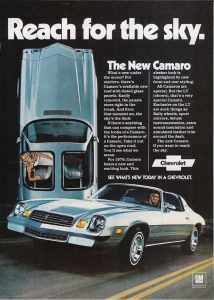
When was the last time you saw an old Beetle out on the road?
That’s because they’ve been off the market – in the U.S. – for more than 40 years, not because people didn’t want to buy them anymore but because the government (via its regulations) made it impossible for VW to sell them (in the U.S.) anymore.
A similar thing is about to happen to Camaro – which reaches the end of its line after the end of this year. It is also going away because of the government. More finely, because GM has been going along with the government – and the government doesn’t want GM (or anyone else) making cars like Camaro anymore.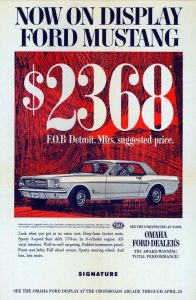
It wants everyone to make devices, instead.
And GM has decided to go along with that.
What It Is
The Camaro is Chevrolet’s alternative to the Mustang, which was the car that singlehandedly created such enormous demand for cars of this type after its 1964 debut that a new name for vehicles of this type – the pony car – was created for them.
They were smaller than muscle cars – and less ponderous. They didn’t have to be muscular, either – which a muscle car had to be else it isn’t one. While you could get a muscular pony car, that aspect was optional. What was always standard was fun – and enough room for four (even if there wasn’t much room for two of the four) in a good-looking package that almost everyone liked.
And which almost anyone could afford.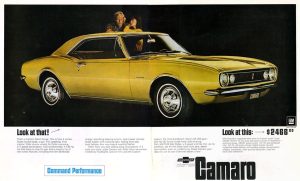
That latter has changed a lot over the years – and it is part of the reason why Camaro no longer sells as well as it used to. And that’s part of the reason why it’s going away.
In 1977, the beginning of the high point of Camaro sales success, a base Camaro coupe listed for $4,113 – which works out to just over $22,000 today. You could get a new ’77 Z28 for less than the equivalent of $30k back in the day.
Today, a base (1LT) 2024 Camaro coupe lists for $30,900 – which puts it out of reach of people who might be able to swing just over $22k.
You do get a lot more for the money today – including a standard 3.6 liter V6 that makes a lot more power than the 5.7 liter V8 that powered the Z28 back in ’77. Plus features such as AC, power windows and locks that were extra-cost back in ’77. As well as features – such as 18 inch wheels, a six speed manual transmission and a six speaker stereo – that weren’t even available back in ’77.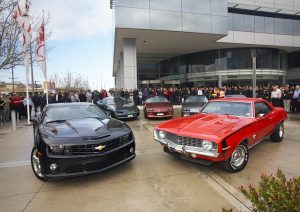
But none of that’s much good if a person can’t afford it.
A 2LT – which stickers for $32,900 – adds heated and ventilated front seats and dual-zone climate control AC (which you had to buy a Cadillac back in ’77 to get).
The $36,900 3LT coupe includes a nine speaker Bose audio system, a heated steering wheel, customizable ambient interior lighting and a wireless cell phone charger, among other upgrades.
If you’d like a lot more engine (and power) to go with that, the high-performance LT1 ($38,800) has what you’re wanting. It comes standard with a 6.2 liter V8 that’s not only bigger than any V8 you could get in a Camaro Z28 from ’77 until the current Camaro came along – it makes more than twice as much power. In addition to that, you also get an engine oil cooler, high-performance Brembo disc brakes up front, a 20 inch wheel/tire package and heavy-duty suspension.
The SS (Super Sport) is basically the same Camaro but with Brembo bakes all around, more aggressive “summer” tires on the 20 inch wheels, a rear spoiler and “SS” badging. It stickers for $42,300.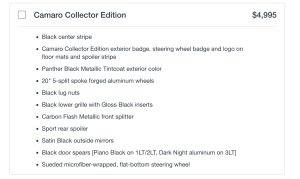
At the apex of the Camaro lineup is the $72,100 ZL1 – which shares its name with the biggest-engined, most muscular Camaro you could buy back in the day. Today, a ZL1 has a lot more muscle – courtesy of what can be thought of as steroids for an engine. That is to say, a supercharger for the 6.2 liter V8 that adds almost 200 more horsepower. Also included are even more aggressive tires – and even more capable brakes – along with a host of related high-performance upgrades.
Most trims are also available as convertibles, too.
The Camaro’s only direct competition is, of course, the Mustang – which is similarly laid out and comparably priced.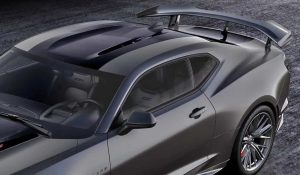
What’s New For 2024
For the Camaro’s final year, Chevy has added a Collector Edition – which is a $4,995 package that can be added to most Camaros. It includes special Panther Black metallic paint with center stripe, a set of 20-inch matte black wheels with black lug nuts, a carbon fiber front air splitter, suede microfiber-wrapped flat-bottom steering wheel and Camaro Collector Edition badging inside and out.
Also, for the Camaro’s last year, the previously standard 2.0 liter turbocharged four has been dropped.
Standard V6 replaces previously standard turbo four – and outguns Mustang’s standard turbo four.
Manual transmission is standard with the V6; it isn’t available anymore with the Mustang’s standard turbo four.
Back seats give you a place to put what won’t fit in the tiny (9.1 cubic foot) trunk.
What’s Not So Good
Camaro is well-equipped but too-expensive for the mostly young buyers who like cars like this.
Two-seater Corvette has more space for cargo than four-seater Camaro.
GM is giving up on Camaro – because it is committed to making battery powered compliance-devices going forward.
The 2024 Camaro’s standard engine is a 3.6 liter, 335 horsepower V6 paired up with a six speed manual transmission. It’s a bigger, stronger engine than the Mustang’s standard 2.3 liter, 315 horsepower four cylinder engine – which is also paired up only with an automatic transmission.
This is an interesting inversion in that for most of the 60 years there have been pony cars, it was usually the case that the standard engine came with what used to be called a standard – that is, manual – transmission. Not so much because of any performance advantage but because of the economy advantage. The manual-equipped car cost less to buy because the manual cost less to manufacturer and sell than the automatic.
Today, the automatic provides a fuel economy advantage.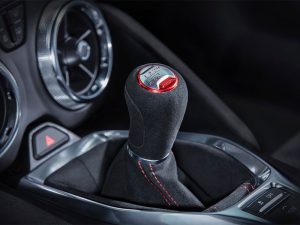
The Mustang’s standard ten speed automatic has four more gears than the Camaro’s standard six speed manual – and multiple overdrive gears, to reduce engine RPM more and sooner. That plus two fewer cylinders enables the turbo four Mustang to post 22 MPG in city driving and 33 on the highway – the latter by far the best mileage ever posted by a pony car.
But it is an automatic-only pony car – unless you pay about $10k more (roughly) to get the V8-powered of the Mustang, the GT. Then you can have a six speed manual transmission.
Chevy offers it – plus two more cylinders – for the same price that Ford charges for the turbo-four/manual-only Mustang. Which comes standard with 20 less horsepower, too.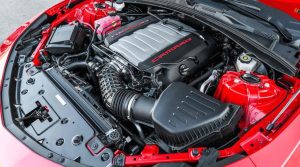
The Camaro’s optional 6.2 liter, 455 horsepower V8 is the most powerful and biggest V8 Chevy has put into a mass-produced Camaro. There have been a few that were bigger – such as the 454 cubic inch (7.5 liters in the anodyne metric measure used today) but it was only offered in a relative handful of early ’70s Camaros – and it didn’t put down 455 horsepower.
Never mind what it said on the sticker.
This engine is also available with either a standard six speed manual or (optionally) a ten speed automatic (which, interestingly, is the same automatic used in the Ford; this transmission was developed jointly to save on manufacturing costs).
Also interestingly, the Camaro’s 6.2 V8 rates 16 city, 24 highway – almost the same mileage as the standard 3.6 liter V6.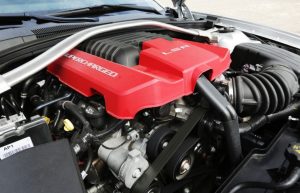
The V8 Camaro also has more range – 304 miles in city and 456 miles on the highway – than the V8 Mustang GT, which has only 224 miles of city driving range and 368 miles of range on the highway. Not because the Ford’s V8 uses more gas but because it needs more gas, sooner – because it only carries 16 gallons while the Camaro comes standard with a 19 gallon tank.
On The Road
The base (V6 powered) Camaro gets to 60 in about 5 seconds. That is quicker than all of the V8-powered Z28 Camaros made from the beginning – back in 1967 – all the way through the early ’90s, by which time a Z28 was just about as quick as a V6 Camaro is today.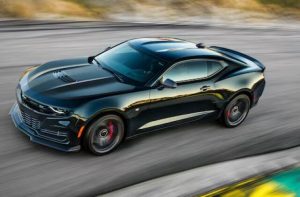
It is also – subjectively – more fun to drive quickly than the base (turbo four/automatic-only) Mustang, even though the latter is just as quick, notwithstanding it has two fewer cylinders and a much smaller engine. Ford does a fine job of programming the ten speed automatic to shift fast and firmly and you can select from multiple driver-selectable programs to get the shift action you like best. But there’s less physical interaction between driver and car; the Camaro with the manual is thus more of a driver’s car.
The V8 Camaro is a ferocious car – even without the supercharger that comes with the ZL1. It is the apotheosis of Camaro performance. It performs better with the automatic because all of that power is more controllable. But the manual’s still a lot more fun for precisely that reason. It’s kind of like firing a .50 caliber Desert Eagle and trying to keep on target. You’d likely be more accurate with a 9mm – but who cares?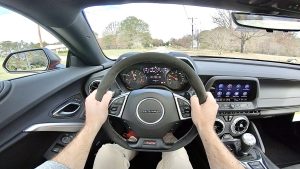
The Camaro’s handling – and the ride – are better than either ever was – in part because this last-of-the-line Camaros shares its basic chassis with the Cadillac CT4 (more about this also soon-to-be-gone car here) which, of course, is a luxury-sport sedan. A kind of four-door Camaro, if you like. Or, if you prefer, the Camaro is a two-door CT4.
It’s pretty much the same thing either way.
Over the years, I’ve owned five Camaros – and driven one of every kind made up to now. This one is – by far – the most settled and capable example of them all. It’s just a shame it’s so hard to see out of it.
The last Camaro is designed to remind us of the first Camaro – the one that made its debut back in ’67 and carried over to 1969. It has similarly hunky styling and it’s immediately recognizable as what it is – much as the Mustang is (and the Dodge Challenger was).
The new – and last – Camaro is a little smaller than the first-generation ’67-’69 Camaro, which was 184.7 inches long – but it rides on longer (110.7 inch) wheelbase vs. the ’67-’69’s 108 inch wheelbase, which make sit appear longer.
Interestingly, the current Camaro stands about two inches taller than a ’67-69 did. It’s interesting because it feels a lot tighter inside the new Camaro, especially in the back seat.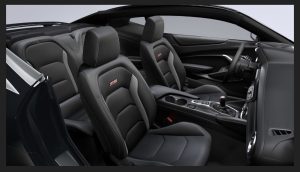
Camaros have never been cars with much backseat passenger room but this Camaro has the least of any of them. Especially insofar as rear seat headroom, which drops six inches from up front, where there’s 38.5 inches. In the back, just 32.5 inches. That – more than the 29.9 inches of backseat legroom – makes the Camaro effectively a two-seater, with the back seats making up for the extremely small (9.1 cubic foot) trunk.
The Mustang’s rear seats have about two inches more headroom (34.8 inches) and the Ford’s 13.1 cubic foot trunk is about the same size as that of a current compact-sized sedan’s. It’s not a huge difference but it does make a difference – in terms of making the Mustang a more practical pony car than the Camaro.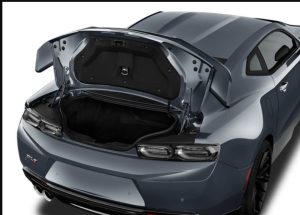
But a more affordable one would be even better – because more would sell and that might have kept Camaro around for longer.
The base ’24 model costs more than a Z28 did back in the ’70s. Granted – and as already explained – a ’24 V6 Camaro outperforms those classic-era Z28s but (again) it doesn’t really matter if most people who might want a new Camaro can’t afford one.
One way to make it more affordable would be to not include some – or even most – of the standard features such as the leather-trimmed steering wheel, the power front seats and the six speaker stereo. If they were options, they’d probably add $2,500 to the car’s price. Why not make them options – so that $2,500 could be taken off the price?
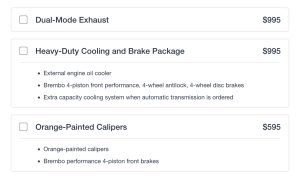
Not having to buy climate control AC and six air bags would really help bring the cost of a new Camaro more in line with what a Camaro cost back when Chevy was selling 100,000 of them annually. But that would entail GM telling the government to stop mandating things its customers increasingly can’t afford to buy.
Or want to buy.
On the other hand, you can buy several performance upgrades for the base Camaro a la carte, including a “dual mode” exhaust that can be electronically uncorked for more performance and the sound of more performance and a heavy-duty cooling/brake package.
So equipped, a V6 Camaro is more than a match for any classic-era V8 Z28.
Also, Chevy offers a V8 in Camaro – in the LT1 trim – for thousands less than cost of an SS Camaro or a V8 powered Mustang GT.
The Rest
It’s sad to see the car that has outlasted practically every other car GM has introduced since the first Camaro was introduced back in 1967 fade away. But pulling the plug on Camaro is preferable to putting a plug in Camaro. 
A battery powered Camaro would be like a cold cup of brown-colored warm water calling itself “coffee.” Better to hang onto memories if what we used to take for granted than pretend what we’re allowed to have now is what it ain’t.
The Bottom Line
If you want a new pony car that isn’t a Mustang, this is your last chance.
. . .
If you like what you’ve found here please consider supporting EPautos.
We depend on you to keep the wheels turning!
Our donate button is here.
If you prefer not to use PayPal, our mailing address is:
EPautos
721 Hummingbird Lane SE
Copper Hill, VA 24079
PS: Get an EPautos magnet or sticker or coaster in return for a $20 or more one-time donation or a $10 or more monthly recurring donation. (Please be sure to tell us you want a magnet or sticker or coaster – and also, provide an address, so we know where to mail the thing!)
If you like items like the Baaaaaa! baseball cap pictured below, you can find that and more at the EPautos store!





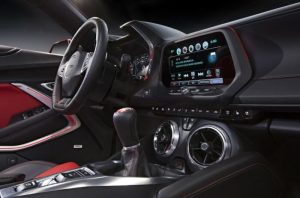
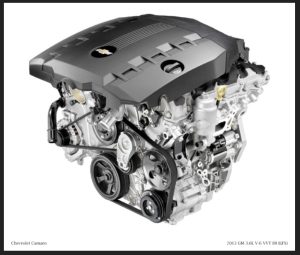



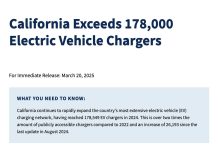

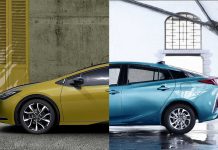

Dad, nouveau rich, bought me a new 3rd generation Camaro as my first car.
It turned out to be under-engineered mechanically, with unreliable electronics.
Had he instead bought a used 2nd generation (or 1st) I talked about I’d likely still have one.
And both myself & my boys would have spent many hours turning wrenches with it.
Sigh…what could have been…
Hi Bill,
I once owned an ’86 RS with the 2.8 V6 and actually liked the car. It wasn’t quick but it was a good-handling car that was also not entirely impractical due to the huge rear glass hatchback. I wish I’d kept it!
They intend to make it so expensive and miserable to drive that people will just give up, move into a $3000/month studio apartment, and eat their bug patties. At least they will have a sail fawn to stare at until they can’t afford the payments on those.
Eric, does the camaro share the same platform with Caddy’s CT4-5?
If so, then the end of camaro does indeed bother me, because it makes the chances of CT4-5 go away too. If so, a sad day for the wife and I. We enjoy the CT4 a lot and hoped to keep buying them over time.
OR, does any other vehicles GM makes share the camaro platform? Then the Caddy’s may have a chance…
Eric, does the camaro share the same platform with Caddy’s CT4-5?
If so, then the end of camaro does indeed bother me, because it makes the chances of CT4-5 go away too. If so, a sad day for the wife and I. We enjoy the CT4 a lot and hoped to keep buying them over time.
OR, does any other vehicles GM makes share the camaro platform? Then the Caddy’s may have a chance.
The Govco shakedown explained:
‘Chrysler parent Stellantis paid $190.7 million in civil penalties for failing to meet U.S. fuel economy requirements for 2019 and 2020, and owes another $459.7 million in outstanding penalties, government documents seen by Reuters show.
‘The Italian-American automaker in 2023 paid a record setting $235.5 million for the 2018 and 2019 model years and paid a total of $156.6 million in penalties for the 2016 and 2017 model years.
‘The penalties, paid in March and May, were disclosed by the NHTSA, which administers the Corporate Average Fuel Economy (CAFE) program.’ — Automotive News
https://archive.ph/0ZaDY#selection-7855.0-7889.192
This is odious and un-American. Penalties are not paid by corporations. They are passed on to the customers.
Now you know why we can’t have Challengers, or Hemi Chargers, or Camaros. A bunch of communist Congress Clowns voted for this shit. Now they have taken away our cars. We should take away theirs, and make them crawl to the Capitol on hands and knees, as we jeer and fling feces at their scurvy selves. Diseased jackals!
A visit to the catacombs of Clowngress:
https://www.youtube.com/watch?v=MdSfiskfVsE
Chevrolet Camaro SS 1LE lapping the Nürburgring…
The lucky owner has lapped the ring many times in his Chevrolet Camaro SS 1LE…it is his entertainment….he likes the car…he says it just works…is a great car…
https://www.youtube.com/watch?v=Vs8m-g3lRgM
Rented a convertible Camaro a few years ago. Basically, the same style as of the ’24. The visibility was *absolutely* horrible!!! I mean, it was a deal-breaker for me, as if I were to consider purchasing this car model. Even with the top down, it was bad. Sides of the doors come up too far, and roofline too low. Good hardware, though, the 6.2 LS motor is a great motor, and the last of its kind.
I rented a (then) new 2023 Camaro last Spring, and the engine was already burning oil with only a few thousand miles on the odometer.
OT: Hulk Hogan speaks at the GOP convention. Once Creepy Joe officially drops out, this will be the 2024 race
https://m.youtube.com/watch?v=flCjC_bqnq8
Sad to see the Camaro go.
Whenever I see a Challenger, Mustang, or Camaro, I think, “that’s a good looking car”. Stylistically, they are what cars should look like. And they have the horses and sound to back it up.
But heck, why shouldn’t our central planning overlords dictate what we should be driving? They do such a good job at everything else /s/
It is sad, but I’d rather see it go than become gelded.
If automakers had said “we’re making this, or nothing at all” — and stuck to their guns — 50 or 30 or even 15 years ago, we wouldn’t be in this mess today.
When you consider that both the Mustang and Camaro were both based on economy cars you can see why they were both affordable back in the day. Today of course these cars are performance cars that implies that the car is more capable of spirited driving.
If they tried to build a modern version of the base 6 cylinder cars it would probably be a FWD car and the performance version being RWD.
As you said Eric if you don’t want to sell them why would you build a modernized version of the 6 cylinder Camaro with wind up windows, no AC etc. and make those things optional?
Probably most people wouldn’t buy the stripper version and dealers would only order them with power everything for a better profit.
PS: the first and second generation Camaros looked nicer. The later ones not so much.
Last night Trump said he’s going to end EV mandates & return automobile manufacturing to the USA. The first statement I believe, the second not so much. If US automakers make autos that nobody wants and can afford, then there’s no need for expansion in the US.
Maybe an investor revolt will oust Marry Barra and her ilk. That only works if the premium shares are held by individuals / entities other than Blackrock and Vanguard.
You often speak of the five year design cycle in getting a vehicle into the showroom. Meaning the EVs that are on the road today were in the planning stage 5 or more (likely more given the COVID times) years ago. So let’s just say 2017 for argument. May 1, 2017 the FED raised their interest rate to 0.08% after about 9 years of the rate hovering around 0.0%. Why wouldn’t you finance a car purchase if GMAC is basically paying you to take it? Sure they make it up on the sticker price, but who cares? That payment could be made with a part time job and occasional “presents” from mom and dad.
Now, with interest rates up above 5%, that $30K sticker price doesn’t sit as well into the budget. If you feel your job prospects are good maybe stretch out that payment another year or thee. But if you’re deemed a credit risk in any way you’re not going to get the best rate, you’re not going to get a deal and you’re probably going to be leasing.
Sticker prices are going to have to come down. Or the only people who can buy cars are people who already own them, and can get a good deal on a trade.
‘one of the most popular, best-known cars ever made is about to fade away.’ — eric
In parts of Africa, people get headstones carved in the shape of a Mercedes Benz — perhaps to cherish for eternity something they couldn’t have during their earthly life.
GM’s post-liquidation corporate headstone, of course, should be a Camaro — symbolizing all it once was, until it succumbed to Wokery, EeeVees and abject collaborationism. Listen up, Mary:
Eres el demonio vestido ‘e mujer
Tu nuevo apodo será Lucifer
Nadie merece morir
Pero a tu funeral no irá ni un perro
You are the devil dressed as a woman
Your new nickname will be Lucifer
Nobody deserves to die
But to your funeral not even a dog will come
— Aventura, Peligro